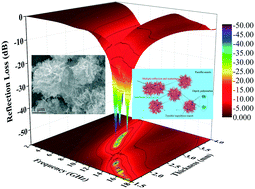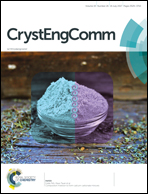An impedance match method used to tune the electromagnetic wave absorption properties of hierarchical ZnO assembled by porous nanosheets†
Abstract
In this study, three hierarchical porous ZnO flowers were prepared via calcination of the precursor at different temperatures (400 °C, 500 °C and 600 °C). It can be found that the calcination temperature influences the porous structure and size of the ZnO nanoparticles. The porous structure can effectively tune the permittivity to improve the impedance match. The porous ZnO flowers obtained at 400 °C show a large surface area and small size of ZnO nanoparticles and thus, hold good impedance match. Moreover, the porous ZnO flowers self-assembled by nanosheets can induce multiple reflection and scattering, which prolong the microwave travel path and consume more electromagnetic energy. Therefore, the porous ZnO flowers obtained at 400 °C exhibit outstanding microwave absorption properties. The minimal reflection loss is −46.1 dB at 13.6 GHz with only a thickness of 1.9 mm. The absorption bandwidth of RL less than −10 dB can reach up to 11.5 GHz (6.5–18.0 GHz) by adjusting the absorber thickness (1.5–4.0 mm). The lightweight, small thickness, and strong and tunable absorbing properties of the porous ZnO flowers make it attractive for developing a high-performance electromagnetic wave absorber.



 Please wait while we load your content...
Please wait while we load your content...